 Usually when you hear the word hurricane and NASA in the same sentence you think of missions getting scrubbed at Cape Canaveral by an approaching storms. However, this month NASA launched a new Hurricane and Severe Storm Sentinel (HS3) program to begin monitor these storm systems from altitudes higher than current storm chase planes can reach.
Usually when you hear the word hurricane and NASA in the same sentence you think of missions getting scrubbed at Cape Canaveral by an approaching storms. However, this month NASA launched a new Hurricane and Severe Storm Sentinel (HS3) program to begin monitor these storm systems from altitudes higher than current storm chase planes can reach.
As the agency points out:
Close to 100 million Americans now live within 50 miles of a coastline, thus exposing them to the potential destruction caused by a landfalling hurricane. While hurricane track prediction has improved in recent decades, improvements in hurricane intensity prediction have lagged, primarily as a result of a poor understanding of the processes involved in storm intensity change. The Hurricane and Severe Storm Sentinel (HS3) is a five-year mission targeted to enhance our understanding of the processes that underlie hurricane intensity change in the Atlantic Ocean basin. HS3 will determine the extent to which either the environment or processes internal to the storm are key to intensity change.
HS3 – NASA Science Missions
In recent local coverage, Bill Read, former Director of the National Hurricane Center and now with KPRC-2 News, added,“I think the breakthroughs on what makes a hurricane change rapid intensity involves what’s going on in the thunderstorms that makes up the eye wall. I think unmanned aircraft will be important information gatherers if you will, to allow us to come up with a better forecast for the rapid change of intensity,”
(NASA using drones to spy on hurricanes – KPRC 2 News)
The project this year will continue through October, and can be monitored via the NASA HS3 Webpage.
